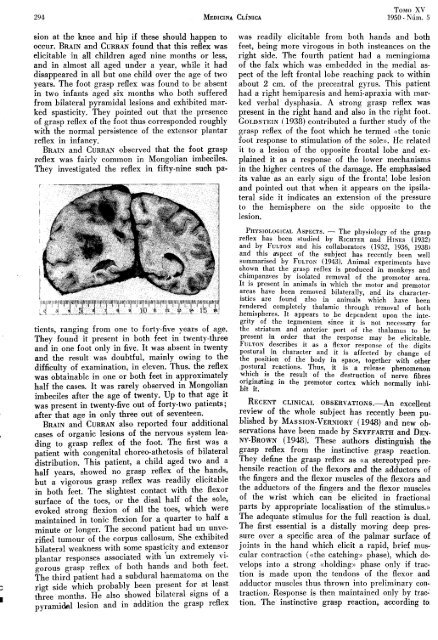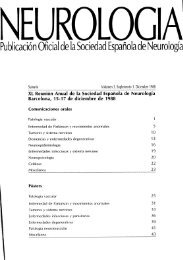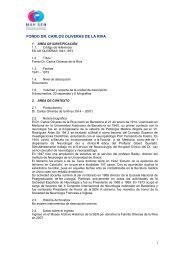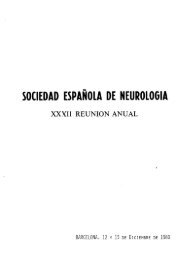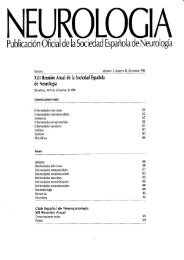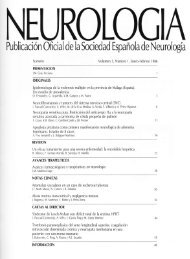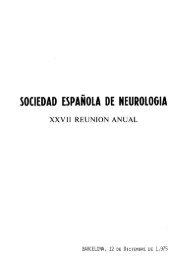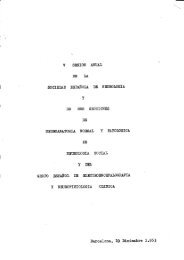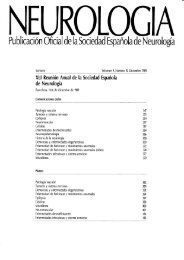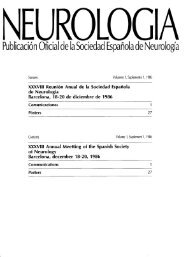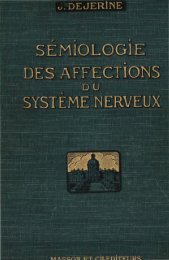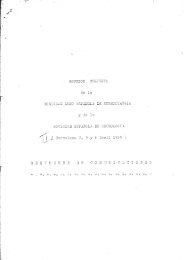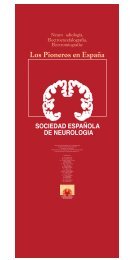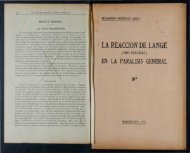Medicina Clínica 1950 (pdf) - Museo Archivo Histórico | SEN ...
Medicina Clínica 1950 (pdf) - Museo Archivo Histórico | SEN ...
Medicina Clínica 1950 (pdf) - Museo Archivo Histórico | SEN ...
You also want an ePaper? Increase the reach of your titles
YUMPU automatically turns print PDFs into web optimized ePapers that Google loves.
sion at the knee and hip if these should happen to<br />
occur. BRAIN and CuRRAN found that this reflex was<br />
elicitable in all children aged nine months or less,<br />
and in almost all aged under a year, while it had<br />
disappeared in all but one child over the age of two<br />
years. The foot grasp reflex was found to be absent<br />
in two infants aged six months who both suffered<br />
from bilateral pyramidal lesions and exhibited marked<br />
spasticity. They pointed out that the presence<br />
of grasp reflex of the foot thus corresponded roughly<br />
with the normal persistence of the extensor plantar<br />
reflex in infancy.<br />
BR¡,ru and Cunn,c.n observed that the foot grasp<br />
reflex was fairly common in Mongolian imbeciles.<br />
They investigated the reflex in fifty-nine such pa'<br />
li,<br />
tients, ranging from one to forty-five years of age.<br />
They found it present in both feet in twenty-three<br />
and in one foot only in five. It was absent in twenty<br />
and the result was doubtful, mainly owing to the<br />
difficulty of examination, in eleven. Thus. the reflex<br />
was obtainable in one or both feet in approximately<br />
half the cases. It was rarely observed in Mongolian<br />
imbeciles after the age of twenty' Up to that age it<br />
was present in twenty-five out of forty-two patients;<br />
aftef that age in only three out of seventeen'<br />
Bn¡.I¡r aná Cunn¡rv also reported four additional<br />
cases of organic lesions of the nervous system lea'<br />
ding to grásp reflex of the foot. The first was a<br />
natÉnt wlth co.teenital choreo-athetosis of bilateral<br />
hirtribrrtioo. Thi! patient, a child aged two and a<br />
half years, showed no grasp reflex o-f- the<br />
.hands,<br />
but a vigorous grasp reflex was readily elicitable<br />
in both feet. The slightest contact with the flexor<br />
surface of the toes, ór the disal half of the sole,<br />
evoked strong flexion of all the toes, which were<br />
maintained ii tonic flexion for a quarter to half a<br />
minute or longer. The second patient h-ad un unve-<br />
,ifi.d ,u*o.rt "of th" corpus callosum. She exhibited<br />
bilateral weakness with some spasticity and extensor<br />
nlantar responses associated with'un extremely li'<br />
e.a'sp ,"flex of both hands and both feet'<br />
iil" ,ftitá patient had a subdural haematoma on the<br />
"orou,<br />
ti* ";¿" *hi"h ptobably been present for at least<br />
ii?"" *"ttlls. Hl also showed bilateral signs of a<br />
ly."*i¿"f lesion and in addition the grasp reflex<br />
Mnnrcr¡u Cr,Íxrcl<br />
Touo XV<br />
<strong>1950</strong> - Núm. 5<br />
was readily elicitable from both hands and both<br />
{eet, being more virogous in both insteances on the<br />
right side. The fourth patient had a meningioma<br />
of the falx which was embedded in the medial aspect<br />
of the left frontal lobe reaching pack to within<br />
about 2 cm. of the precentral gyrus. This patient<br />
had a right hemiparesis and hemi-apraxia with marked<br />
verbal dysphasia. A strong grasp reflex was<br />
present in the right hand and also in the right foot.<br />
Gorrlsretl ( I93B) contributed a further study of the<br />
grasp reflex of the foot which he termed . He related<br />
it to a lesion of the opposite frontal lobe and explained<br />
it as a response of the lower mechanisms<br />
in the higher centres of the damage. He emphasised<br />
its value as an early sigu of the frontal lobe lesion<br />
and pointed out that when it appears on the ipsilateral<br />
side it indicates an extension of the pressure<br />
to the hemisphere on the side opposite to the<br />
lesion.<br />
Pnysror.ocrclr- Aspncrs. - The physiology of the grasp<br />
reflex has been studied by Rrcrirn anJ'Hrwrs (1932)<br />
and by Fur-ror,r and his collaborarors (1932, 1936, l93B)<br />
and this aspect of the subject has recently been well<br />
s-ummarised by FulroN (1943). Animal expeiiments have<br />
shown that the grasp reflex is produced in monkeys and<br />
chimpanzees by isolated removál of the promotor area.<br />
It is present in animals in which the motoi and premotor<br />
areas have been removed bilaterally, and its "ir..u"t".istics<br />
are found also in animali which have been<br />
rendered completely thalamic through removal of both<br />
hemisph-eres. lt appears to be dependent upon lhe integrity<br />
of the tegmentum since ii is not irecessary for<br />
the striatum and anterior port of the thalamus io be<br />
present in order that the response may be elicitable.<br />
Fulror describes ir as a flexoi response of the digits<br />
postural in character and it is affected by change of<br />
the position of the body in space, togethei ¡uith lther<br />
,postural reactions. Thus, it ii a reléase phenomenon<br />
which is the result of the d'estruction of i.*" n¡.".<br />
originating in the premotor cortex which normally inhibir<br />
it.<br />
Ruce¡'tr cLrNrcAL oBSERvATroNs.-An excellent<br />
review of the whole subject has recently been published<br />
by MnssroN-VBRNroRy (1948) and new -observations<br />
have been made by Ssyrranrn and Dr¡v.<br />
Ny-BRowN (1948). These authors distinguish the<br />
glasp reflex from the instinctive grasp reaction.<br />
They define the grasp reflex as na siereótyped prehensile<br />
reaction of the flexors and the adductori of<br />
the fingers and the flexor muscles of the flexors and<br />
the adductors of the fingers and the flexor muscles<br />
of the wrist which can be elicited in fractional<br />
parts by appropriate localisation of the stimulus.><br />
The adequate stimulus for the full reaction is dual.<br />
The first essential is a distally moving deep pressure<br />
over a specific area of the palmar surface of<br />
joints in the hand which elicit a rapid, brief muscular<br />
contraction ( phase), which de.<br />
velops into a strong phase only i{ traction<br />
is made upon the tendons of the flexor and<br />
adductor muscles thus thrown into preliminary con-,<br />
traction. Response is then maintained only by traction,<br />
The instinctive grasp reaction, according to


